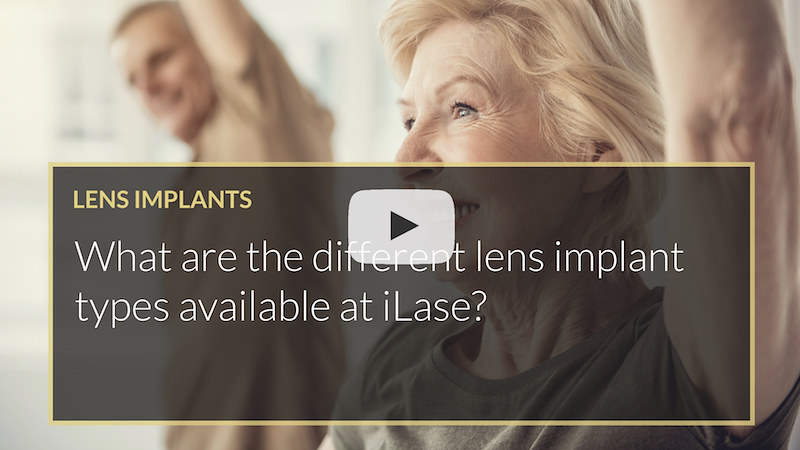
IN THIS VIDEO PROF MOHAMMED MUHTASEB DISCUSSES THE DIFFERENT TYPES OF LENS IMPLANTS
What are the different types of lens implants available at iLase?
In my practice, I use a range of intraocular lens implants to replace the natural lens of the eye. This is necessary as part of a cataract operation, or refractive lens exchange procedure. In broad categories, lens implants can either be monofocal or multifocal and within the multifocal category, there are some slight nuances regarding how the lenses achieve multifocality. But in broad-brush categories, monofocal or multifocal.
Monofocal lenses
Monofocal lenses have one fixed point of focus, and usually, patients will want to see in the distance, but then they’ll have to have glasses for reading and to use the computer. Very occasionally, a patient will have been shortsighted throughout their life, then develop a cataract. Still, because of their short-sightedness, they’d been able to see up close without glasses and had glasses for distance. Such patients occasionally want to remain shortsighted. We have a long discussion about the ins and outs, and pros and cons of this choice. Still, if after the discussion, a patient wants to remain shortsighted, we can place a monofocal lens so that they stay shortsighted. Then the distance vision is blurred, and they have to wear glasses for far away.
Take the first step to understand your unique cataract surgery options
Most people have cataract surgery without knowing about all the options they actually have surrounding cataract surgery. Did you know it is not only possible to fix your cataracts but you can often fix your reading and distance vision at the same time? Click the button below to request a personal consultation and get clear on all of your options.
Multifocal lenses
Multifocal lenses give the ability to see in the distance, and up close. Sometimes the vision improves in between as well. For example, when someone is using a computer, we can help to see the screen better, if the patient is suitable and if, following the discussion regarding the lens choices, they feel that the multifocal lens is better suited to them.
Whichever kind of lens implant is chosen, any astigmatism can be corrected, and certainly, that preexisting astigmatism is not made worse by the surgery. Toric lenses correct astigmatism, and both monofocal and multifocal lenses come in Toric varieties.
I invite you to book a consultation in order to determine your suitability for refractive cataract surgery, or refractive lens exchange. It’s the only way to determine your suitability for these procedures and to have an in-depth discussion regarding the risks and benefits of each of them. I look forward to seeing you there and taking you through the journey to achieving your desired post-operative outcome.
Share This Story, Choose Your Platform!
ABOUT THE EXPERT
Prof Mohammed Muhtaseb, FRCOphth
Consultant Cornea, Cataract and Refractive Surgeon
iLase is the private practice of Consultant Ophthalmic Surgeon, Prof Mohammed Muhtaseb. Based in South Wales, he is one of the very few ophthalmologists working in the UK who is a fellowship-trained specialist in Cornea, Cataract and Refractive Surgery. He holds full specialist registration with the General Medical Council and was appointed as a Consultant in the NHS in 2006.




